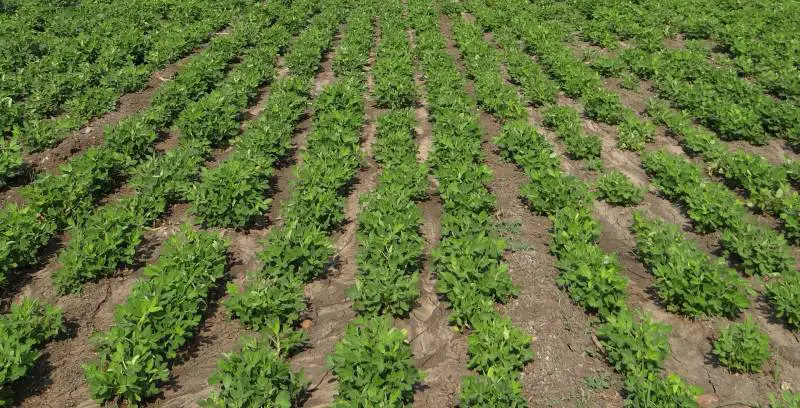Where Do Peanuts Grow [In The U.S & World]

Peanuts have been grown for decades due to their nutritional value. They bloom like typical plants, but the nuts develop under the soil as part of the root system. The peanut flowers are self-pollinating. Once fertilized, they form tentacles that penetrate the soil to form peanuts.
Peanut plants ripen their pods underground, making them acquire the common groundnut name. These nuts do well in warm climates where soils are sandy.
However, this cannot stop you from growing them in your garden if the conditions are right.
The best time to grow peanuts and mature is in areas where the planting cycle lasts more than four months.
Peanuts sprout when the soil temperature is maintained s 18 degrees centigrade. Delayed germination means the soil is not warm enough. This makes them ideal for warm climates when planted in early summer or late spring in cold regions.
Where Do Peanuts Grow In The World?
Peanuts are grown for commercial and household consumption. When grown as a rotation crop, peanut enriches the soil, and you can rotate them with maize or similar crops.
The nuts are easy to grow and are not heavy feeders making loose sandy soils their favorite.
As mentioned earlier, peanuts do well in warm climates. They are spread across the globe, with the bulk growing in Asia, Australia, Africa, and some North and South American parts. However, the nuts’ largest producers are India and China, contributing over half of the global peanuts.
In terms of high yields per acre, America takes the lead and produces around 10 percent of the total peanut globally.
In terms of high-quality peanuts, Nigeria, South Africa, Senegal, Brazil, Sudan, and Argentina take the lead.
High-quality groundnuts, also known as “Golden peanuts,” are famously produced in Argentina.
On more than 35,000 hectares of land, peanuts can be grown in amounts of almost two million tons.
Where Do Peanuts Grow In The United States?
America is endowed with both tropical and sub-tropical climates. This makes it an ideal location to grow nature peanuts. However, the nuts do not do well in all states. Yet, the demand for peanut products has seen the spread of the nut growing in several states.
For commercial purposes, peanuts are grown in 13 states. These include Virginia, Texas, Florida, North Carolina, Alabama, Missouri, South Carolina, Arkansas, Louisiana, New Mexico, Mississippi, Oklahoma, and Georgia.
Over 53 percent of the total peanut grown in the U.S. comes from the state of Georgia. However, the peanut-growing regions are divided into three zones;
South-west Peanut Growing Region
The South-West zone includes New Mexico, Arkansas, Texas, and Oklahoma, where the Spanish variety of peanuts thrive. This region contributes 14 percent of the total peanuts grown in the United States. Spanish peanuts come with relatively small kennels with a high yield per plant.
This type of peanut is reddish-brown when ready for harvesting. They are popular in the production of peanut butter and also edible oil production. However, they can be roasted and salted for table used.

South East Peanut Growing Zone
Alabama, Florida, Georgia, and Mississippi form part of the South-East peanut growing region of the U.S. These states grow the runner peanut (medium kennel) and Spanish varieties. This region contributes 74 percent of the total peanut crop grown in the U.S.
The runners are medium kennel peanuts and slightly bigger with smooth kennels compared to the Spanish type. Their uses are similar but preferred in candies and snacks. The taste for the ordinary user is the same as that of the Spanish variety.
Virginia-Carolina Peanut Growing Region
Of all the varieties grown in the United States, Virginia peanuts are the biggest and crunchiest. The third region comprises Virginia and Carolina, which grow the large kennel Virginia variety, contributing 12 percent to the total peanut grown in the United States. However, in recent years, this variety has made growing inroads in Georgia, Texas, and New Mexico.
Virginia is larger than the medium kennel runner and takes an oval shape. In Virginia’s southeast, where there is sandy soil this peanut variety thrives most. These are also known as cocktail nuts very popular in sports events and parties. If you love large crunchy nuts, this is the one for you.
Do Peanuts Grow Naturally?
Brief History
Peanuts have been a staple for centuries, with their origin traced back to South America, where they once grew naturally. The peanut is a native of the Western Hemisphere, though it grows in tropical and subtropical areas all over the world. Spanish explorers learned about the peanut’s adaptability and spread it throughout the New World. The spread of peanuts to Asia and Africa later came from traders.
Slaves-carrying sailing ships brought the peanut back to North America in the 1700s. Peanuts were not widely grown in the United States during the 1700s and 1800s, despite the existence of a few commercial peanut farms. Due to the peanut’s reputation as a food for the underprivileged and the labor-intensive and slow-growing, and harvesting processes, there was little interest in peanut farming.
Current Times
These plants are legumes and not real nuts making them self-sufficient when it comes to enriching the soil. When peanuts grow naturally, they are of a higher quality than those produced using fertilizers and other chemically enhanced amendments.
Nuts grown using fertilizers are not healthy, giving naturally grown peanuts an upper hand for the health-conscious consumer.
They add nitrogen to the soil, making them the best plants if you practice crop rotation in your farm and garden. Though they are natural foods, they do not grow naturally; Cultivation is important for better yield, with weeding being a top priority.
Natural peanuts are rich in proteins, which are vital in building and repairing your body tissues. What’s more, the fiber contained in the nut keeps your gut working optimally. All you need is to add salt when roasting; you do not need any other additives.
Demand for peanuts and their products keeps rising.
This is a result of the fact that the nut health benefits are many.
Everything that goes into roasting or drying and salting the nuts is natural, and there is no need for additives giving you low-fat levels and zero cholesterol.
Closing Remarks
Peanuts grow on almost all continents but do well in tropical and sub-tropic climates. These unique nuts love the loose sandy soil types. They are easy to cultivate for commercial and home uses. The nuts derive their nutritional value from self-pollinating and the process of the nuts forming under the soil.
What’s more, all the peanut varieties have similar nutritional value and do not require any additives to prepare. As more people become aware of peanut health benefits, its usage will continue to grow. This will see more peanuts growing across the globe.
Whether you are growing for fun, home use, or selling, you cannot go wrong by adding them to your daily menu.
